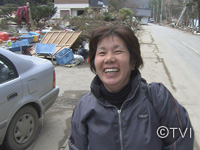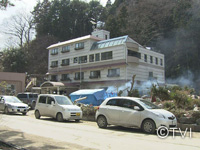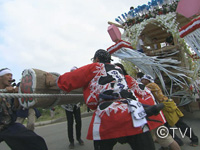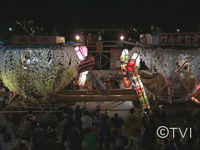TV Station TVI
Great East Japan Disaster : Akiko’s First 30 Days
DC371207![]()
NNNドキュメント‘11 津波にのまれた女将 [TVI]
![]()
![]()


|Length : 24min. |Year : 2012 |
Akiko Iwasaki (age 54) lives by the sea near Kamaishi City in Iwate Prefecture. The inn she owns and operates is hit by the tsunami, destroying the entire first floor. Just then, Ms. Iwasaki was running through the parking lot to escape up the hill but was overcome by the wave. She talks of how she was sucked under like a whirlpool, all went dark and she calmly thought about how she was going to die like this. But then she tried swimming, clambered up to the surface, and was saved by a hairsbreadth.
She opens her ruined inn to 20 plus refugees, supplying her own food stocks and working hard, turning her place into a private evacuation shelter. Next the ruined inn is deemed hazardous for refugee living, and she receives an official order to shut down by the end of March. Akiko Iwasaki, the innkeeper who was sucked under by the tsunami and barely escaped with her life, is now, beyond her will, forced into transience.
Kenka Tanabata : The Float Fighting Festival of Kesencho
DC271233![]()
日本の祭り「ぶつけろ、魂!力の限り!!」 [TVI]
![]()
![]()


|Length : 48min. |Year : 2012 |
Imaizumi Ward, Kesencho, Rikuzen-Takata, Iwate Prefecture, Japan was a historic town that flourished since the Edo Period, and was home to some 2,000 residents in 550 households. Since the days of old, the connections between houses had been strong, and the town still retained the feel of a collective village community.
Kenka Tanabata, the Float Fighting Festival, has been a tradition here for over 900 years. Four groups from neighboring towns each made their own gorgeously decorated floats, then crashed them together full force in this 'rough and tumble' festival. For the locals it was the most important event of the year, with the townsmen preparing months in advance. People young and old looked forward to the festivities.
Then, on March 11, 2011, the Tohoku earthquake shook the region. A tidal wave over 10 meters high engulfed the town, destroying 99% of the homes. 230 people, some 10% of the local population, lost their lives. Where houses once stood in Imaizumi Ward, now is an empty wasteland. Former residents are now separated, relocated to various temporary housing complexes in outlying towns.
However, despite their daily struggle just to get by after the disaster, the townsmen were determined that the festival be continued. They feared that if the festival were discontinued, the people who had once lived here would forever lose their local spirit.
It will take at least 5 years to lay the groundwork for people to be able to live in the Imaizumi area again. For Imaizumi, the festival is the only remaining emblem of the town now razed to the ground; "Until people can come back and live here again..." On August 7th, 2012, at the site of the former main street, the townsmen recommenced the Kenka Tanabata Festival. They wanted to show everyone how not to give up.














